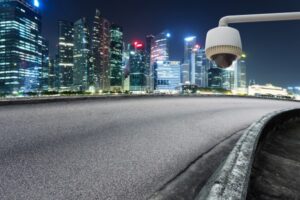CCTV Cameras and Police Robots

CCTV Cameras and Police Robots
Around the world, law enforcement agencies are increasingly relying on technology to help them in their role of maintaining peace. CCTV cameras and, more recently, police robotics are helping in many law enforcement areas.
In the last 10 years or so, Britain has been the most watched country in Europe. Over one million closed-circuit television cameras (CCTV) have been installed across Britain since the early 1990s.
The purpose of CCTV is to enhance formal surveillance, by allowing the police to better monitor citizens’ behavior (including that of potential criminals). The purpose of CCTV is to discourage crime by increasing the likelihood that criminal activity will be detected. CCTV footage can be used to identify criminals who commit crimes in front of the camera. In most urban areas and shopping centres, you can find CCTV cameras. You can find them in many stores, offices and parking lots.
Video and images from CCTV cameras can also be saved and reviewed for a crime that occurred within the camera’s specific view. The law enforcement personnel can use real-time monitoring when eyewitnesses are not available or there is conflicting evidence.
CCTV cameras can be useful for static surveillance. But what if the crime was not committed in plain sight? Police robots can help in this situation.
In May 2017, a robot using cameras, internet and artificial intelligence joined the Dubai police force.
The “Robocop”, an autonomous robot, began its duties on the 23rd of May by welcoming guests to the opening ceremony of the 4th Gulf Information Security Expo and Conference at the Dubai World Trade Center. The robot is nearly 70 inches tall. The robot is nearly 70 inches tall and weighs 220 pounds. The “emotion detector” can recognize hand signals and gestures up to five feet away. The emotion detector can detect whether a person is smiling, happy or sad and change their greeting and expression accordingly.
Robocop also has the ability to map out the interior of a building, navigate autonomously using its self-control feature and drive. It also comes with a tablet built in that allows people to interact with the robot and pay for services. The robot can also communicate in six different languages. It is able respond to questions, shake hands and even give a salute.
Police robots can also be used to reach areas that are difficult to access or dangerous to first responders or in which more law enforcement is required. The Cleveland Police, for example, had some nonlethal robots on hand during the Republican National Convention of July 2016.
“Robots, autonomous machines and the Internet of Things are redefining and shaping our future. They’re also changing how we work.” Robots can now talk, see and feel objects and people. The robot age is here, not coming, said Trixie LohMirmand Senior Vice President Exhibitions & Events Management at DWTC.
SUPERIOR® Optics manufactures and designs optical lenses for robotic policing, CCTV cameras, and high-tech and electronic applications. We have 1000’s standard lens assemblies in stock and can design a custom solution for scanners and CCTV cameras, CCD/CMOS systems, medical imaging systems, surveillance systems and night vision systems.
Related Posts
Capturing the Unseen: Exploring the SWIR Fixed Focal Length Lenses
How useful was this post? Click on a star to rate it! Submit Rating As you found this post useful......
What is SWIR Imaging Lenses?
How useful was this post? Click on a star to rate it! Submit Rating As you found this post useful......




